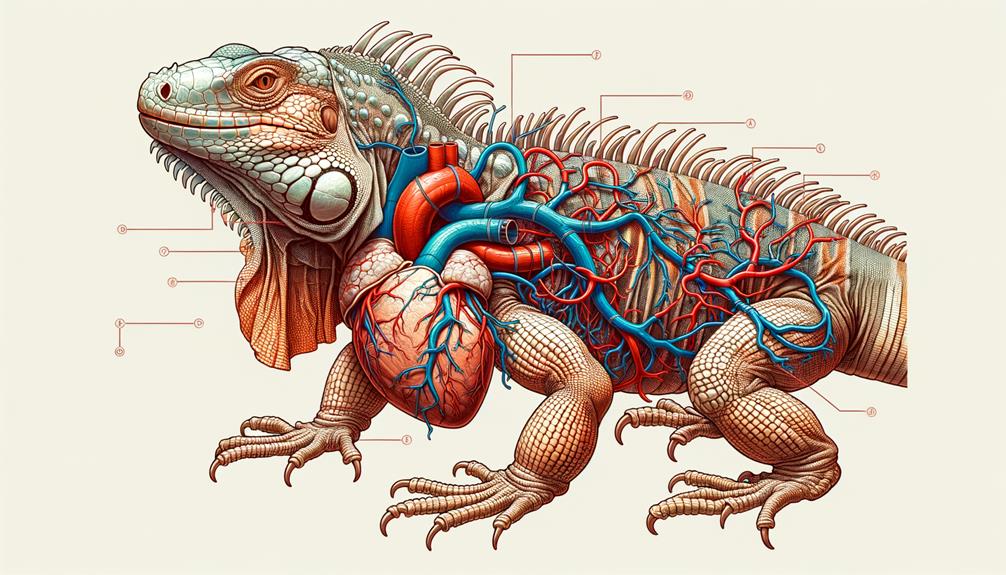Reptiles have remarkable sensory adaptations that help them thrive in their environments. With exceptional vision, some species can see ultraviolet light, which aids in hunting and navigation. When it comes to hearing, lizards use tympanic membranes, while snakes detect vibrations through their jaws. The Jacobson's organ enhances their sense of smell and taste, allowing them to pick up on chemical cues. Snakes also have heat-sensing pits that detect their prey's body heat with remarkable accuracy. Additionally, they can sense ground vibrations, which is crucial for finding prey and avoiding predators. These intricate sensory systems make reptiles highly attuned to their surroundings.
Key Takeaways
Reptiles have evolved advanced visual systems, featuring UV-sensitive cones and adaptive pupil shapes that help them navigate diverse light conditions.
Their sense of smell and taste is heightened by Jacobson's organ, which aids in detecting prey, potential mates, and threats.
Snakes possess specialized heat-sensing pits that can detect infrared radiation and the body heat of their prey.
Reptiles can detect ground vibrations through mechanoreceptor cells in their skin and skeletal structures, allowing them to sense their surroundings.
Reptilian hearing is primarily attuned to low-frequency sounds, with variations in ear structure among species that help them adapt to their environment.
Vision in Reptiles
Have you ever wondered how reptiles see the world with their remarkable eyesight and specialized eyes? Many reptiles have exceptional visual acuity, which helps them navigate their environments with precision. Some species have binocular vision, allowing them to accurately judge distances, a crucial ability for hunting and avoiding predators. Their eyes often contain UV-sensitive cones, expanding their color perception beyond what humans can see. This enhanced color vision is particularly noticeable in many lizards and snakes, making it easier for them to detect prey and communicate with each other.
The shapes of reptiles' pupils vary significantly, from vertical slits to circular forms, adapting to their specific activity patterns. These adaptations enable them to function well in different light conditions, whether they are nocturnal hunters or diurnal foragers. Visual cues play a vital role in their lives, helping with navigation, prey detection, and social signaling.
Some reptiles, like pit vipers, have a specialized sense that detects infrared radiation, allowing them to sense the heat of their prey. This ability complements their vision, making them highly efficient predators. Along with the Jacobson's organ, which aids in chemical detection, reptiles have a finely tuned sensory system that ensures their survival in diverse habitats.
Reptilian Hearing

When looking at how reptiles hear, I notice some pretty big differences in ear structure that affect their ability to pick up sounds. Most reptiles have an eardrum and middle ear, but some, like snakes, rely more on feeling vibrations through their jawbones. The range of frequencies they can detect also varies, with some species being more sensitive to low-frequency sounds that are crucial for communication and staying aware of their surroundings.
Ear Structure Variations
Exploring ear structure variations among reptiles reveals a fascinating array of adaptations tailored to their respective ecological niches. When reptiles first emerged, their auditory systems were relatively simple compared to mammals. Snakes and lizards, for example, exhibit significant differences in their hearing structures. Lizards possess a tympanic membrane and a middle ear with a single ossicle, enabling them to detect airborne sounds, although less efficiently than mammals. This structure is well-suited for picking up low-frequency sounds, which are crucial for communication and detecting predators or prey.
Snakes, on the other hand, have evolved differently. They've lost both the tympanic membrane and middle ear structures. Instead, they rely on their skull bones to sense ground-borne vibrations. This adaptation is particularly effective for their lifestyle, allowing them to sense movements and vibrations from potential prey or threats.
Crocodilians have the most advanced auditory system among reptiles. They possess a distinct eardrum and ossicles that transmit sound vibrations to the inner ear, making their hearing comparable to some mammals. These adaptations are crucial, especially in their aquatic and terrestrial habitats.
Understanding these variations highlights how reptiles' auditory systems are intricately linked to their evolutionary paths and ecological roles, influenced by factors like body temperature and habitat.
Frequency Range Detection
Reptilian hearing is fascinating in its diversity, with a primary focus on detecting low-frequency sounds below 1 kHz. This adaptation is crucial for survival, as it allows reptiles to sense ground vibrations or airborne vibrations of low frequency. While there are some variations across species, this capability remains relatively constant.
Snakes, for example, lack an external ear and eardrum, instead relying on bone conduction to detect ground vibrations. This unique approach enables them to pick up low-frequency sounds efficiently. Lizards, on the other hand, possess more developed ears, allowing them to hear a broader range of frequencies, albeit still limited compared to mammals.
Crocodilians have specialized anatomical adaptations that enable them to hear low-frequency sounds underwater. These adaptations are vital for intraspecific communication, such as mating calls, rather than detecting high-pitched environmental sounds. The simplicity of their auditory system reflects their ecological niche and survival strategies.
A comparative look at reptile hearing adaptations reveals:
| Reptile Group | Hearing Adaptation |
|---|---|
| Snakes | Bone conduction to detect ground vibrations |
| Lizards | Developed ears to hear a wider range of frequencies |
| Crocodilians | Specialized anatomy for low-frequency underwater sounds |
Understanding these adaptive traits helps us appreciate the remarkable evolutionary feats of reptiles, much like their heat-sensitive organs.
Smell and Taste
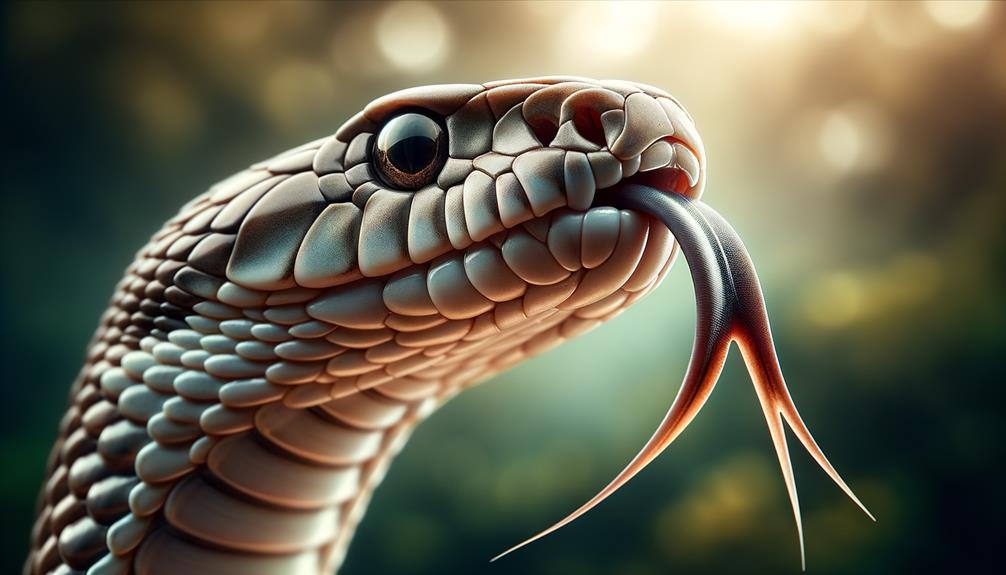
Reptiles have an extraordinary ability to convert tastes into smells, which greatly enhances their capacity to detect prey, mates, and potential threats. The Jacobson's organ, also known as the vomeronasal organ, plays a pivotal role in this process for lizards and snakes. Lizards have specialized organs lining their lips that work in conjunction with the Jacobson's organ to gather chemical cues from their environment. When a lizard flicks its forked tongue, it captures airborne particles and transfers them to this organ for processing.
Snakes take this process to the next level. By flicking their tongues, they collect particles from the air and ground, delivering them to the Jacobson's organ located on the roof of their mouth. This unique sense of smell and taste allows them to interpret their surroundings with remarkable precision. It's an evolutionary marvel that's been refined over 80 million years, making reptiles incredibly perceptive hunters and survivors.
The Jacobson's organ is more than just a survival tool – it's a testament to the intricate and interconnected sensory systems that define reptilian life. This sophisticated sensory apparatus allows reptiles to navigate their world with a freedom and awareness that's unmatched.
Thermal Detection
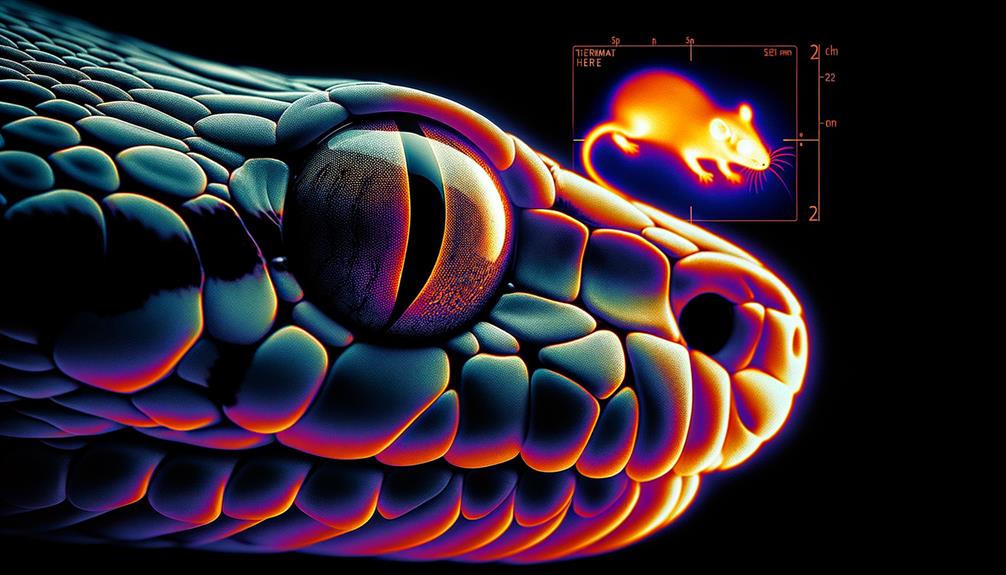
Heat-sensing pits in many snakes, like boas, pythons, and pit vipers, allow them to detect tiny changes in infrared radiation and body heat, even in complete darkness. These specialized organs, located on their lips or the sides of their heads, can sense temperature variations as small as 0.002 degrees Celsius. This extraordinary thermal sensitivity gives snakes a significant advantage when hunting warm-blooded prey, especially at night or in low-visibility conditions.
The heat-sensitive organs are highly attuned to detect infrared radiation, converting thermal energy into neural signals. This unique ability enables snakes to create a thermal map of their surroundings, pinpointing the exact location of their prey. The variation in these senses among different species showcases the remarkable adaptability of snakes to their environments. For example, pit vipers have more pronounced heat-sensing pits compared to boas and pythons, reflecting their reliance on this organ for hunting.
While vibrations and airborne vibrations play a crucial role in other reptilian senses, the thermal detection capabilities of these snakes focus solely on capturing the heat signatures of their prey. This adaptation highlights their evolutionary success in diverse habitats.
Vibration Sensitivity
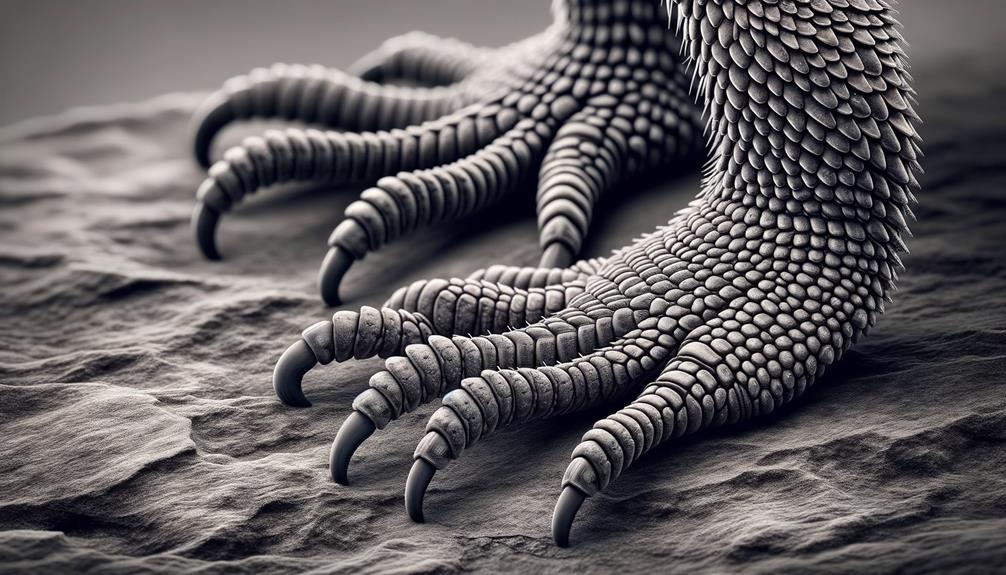
When it comes to detecting vibrations, reptiles like snakes and crocodilians have a remarkable ability to sense ground and water movements through specialized cells in their skin, muscles, and skeletal structures. These cells, called mechanoreceptors, allow them to pick up on low-frequency vibrations, which is crucial for finding prey and avoiding predators. This skill highlights how reptiles rely on touch-based cues, in addition to their other senses, to navigate their environment.
Specialized Sensory Cells
In the world of reptiles, many species have developed extraordinary sensory cells that can detect vibrations in the ground, providing them with vital information about their surroundings. These cells are often found in specific organs, such as the lips of some boas, where they are located in the roof of their mouths, helping them track down prey. This precise detection of vibrations allows reptiles to sense even the slightest disturbances in their environment.
These vibration-sensitive cells are scattered throughout the skin and body wall, giving reptiles an acute awareness of their environment. This ability is crucial for fossorial reptiles, which rely on these cells to navigate and communicate underground. In some species, such as pit vipers, these cells are concentrated in specialized heat-sensing organs that enable them to detect the heat signatures of warm-blooded prey with remarkable accuracy.
The sensitivity of these vibration-detecting cells varies greatly among reptile species. Some can sense disturbances from several meters away, while others have a more limited range. This variation in sensitivity is vital for the different ecological niches that reptiles occupy, ensuring their survival and success in diverse habitats.
Ground Vibrations Detection
Detecting ground vibrations is a crucial survival skill for many reptiles, allowing them to navigate and hunt in environments where visual cues are scarce. Over millions of years, reptiles have fine-tuned this ability, which is particularly vital for burrowing snakes that can sense prey in complete darkness.
Fossil records show that vibration sensitivity has played a significant role in the survival and evolution of many reptile species. Snakes can detect minute ground movements, enabling them to track underground-dwelling rodents and other small animals with precision. Their inner ear structures are directly linked to their sense of smell, which is enhanced by the Jacobson's organ located on the roof of the mouth. This dual sensory system provides them with extensive information about their surroundings.
In dense vegetation or underground burrows, where visual information is limited, the ability to detect ground vibrations becomes vital. This remarkable adaptation highlights the incredible adaptability and evolutionary success of reptiles in diverse habitats.
Predatory and Prey Signals
Building on their remarkable ability to sense ground vibrations, many reptile species have evolved to interpret these signals not only for navigation but also to detect predators and prey with remarkable precision. This vibration sensitivity helps snakes detect even the faintest movements of potential prey or approaching threats. Boas and pythons have fine-tuned their abilities, using their lower jaws to pick up ground-borne vibrations, which are then transmitted to their inner ears.
Monitor lizards have developed a keen sensitivity to both ground and air-borne vibrations. This dual capability allows them to maintain effective detection of both stationary and moving targets in their environment. Their acute vibration sensitivity works in concert with other senses, providing a comprehensive picture of their surroundings.
Crocodilians also exhibit specialized vibration detection. Their ability to sense low-frequency underwater vibrations gives them an edge in hunting aquatic prey. This adaptation lets them pinpoint the location of their prey with minimal surface disturbance, making them more efficient predators.
Turtles, although less specialized, can sense vibrations through their shells, alerting them to nearby threats and aiding in mate location. These sensory adaptations highlight the resourcefulness of reptiles in their quest for survival.
Specialized Sensory Organs
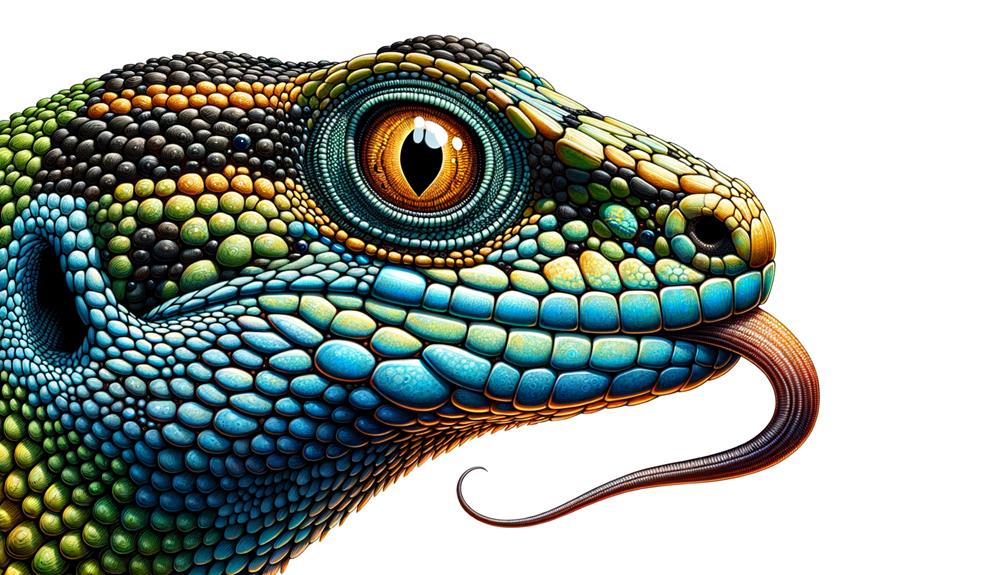
Reptiles' specialized sensory organs, such as the Jacobson's organ and infrared-sensing pits, give them remarkable abilities to detect prey, mates, and potential threats through a combination of taste, smell, and heat detection. These organs are vital for their survival and have evolved in fascinating ways.
For instance, the inner ear of reptiles, although relatively large in lizards and turtles, has adapted over millions of years to help them maintain balance and orientation. This is particularly true for snakes, which have degenerated eardrum and middle ear structures due to their burrowing habits.
Some key features of reptiles' specialized sensory organs include:
Jacobson's organ allows reptiles to detect non-airborne odors, giving them the ability to locate prey, mates, and predators through a combined sense of taste and smell.
Infrared-sensing pits enable many snakes and some lizards to detect the body heat of warm-blooded animals, allowing them to strike accurately in complete darkness.
Visual adaptations in snakes, such as transparent spectacle scales, a unique round yellow lens, and double cone light-sensitive cells in their retinas, provide them with exceptional visual capabilities.
Pressure receptors in reptiles' skin help them sense touch and heat, aiding in their environmental exploration.
These specialized sensory organs highlight the incredible evolutionary adaptations that enable reptiles to thrive in diverse environments.
Frequently Asked Questions
What Are the Sensory Organs of a Snake?
Snakes have a unique set of sensory organs that help them navigate their environment. They possess a Jacobson's organ, which detects chemical cues, and sensitive inner ears that pick up ground vibrations. Infrared sensors allow them to detect heat, while their spectacle scales protect their eyes. Additionally, they have pressure receptors in their skin, providing touch sensitivity.
What Are the 5 Senses of the Sensory Organs?
Imagine hiking and spotting a hawk soaring above. I appreciate how our senses – sight, hearing, smell, taste, and touch – work together seamlessly to provide us with a rich understanding of our environment, helping us navigate the world with confidence.
Do Reptiles Have 5 Senses?
Reptiles have the five senses: sight, hearing, smell, taste, and touch. Their sensory organs are highly specialized, with features like infrared detection in snakes and ultraviolet vision in some species that help them survive.
What Are the Olfactory Organs in Reptiles?
Reptiles have a unique olfactory organ called the Jacobson's organ, located on the roof of their mouth. When they flick their forked tongues in and out, they collect chemical particles from their environment. The Jacobson's organ then analyzes these particles, helping the reptiles to detect subtle cues about their surroundings.



